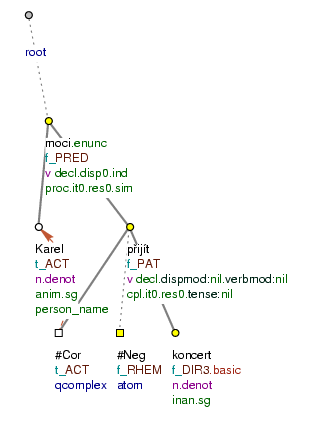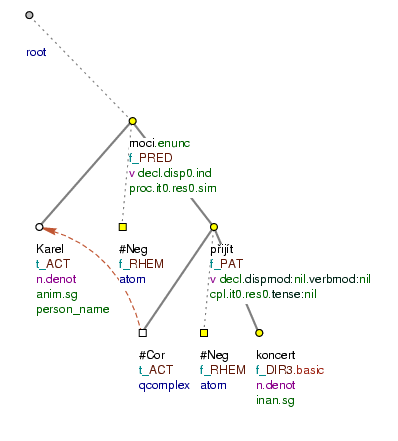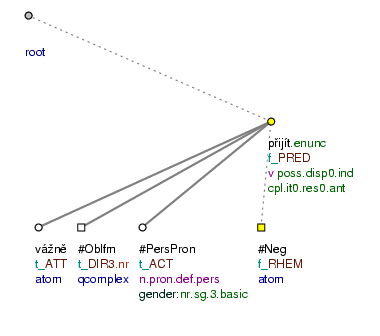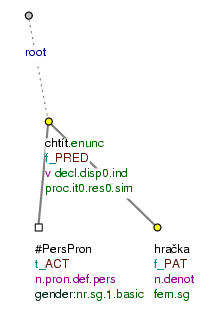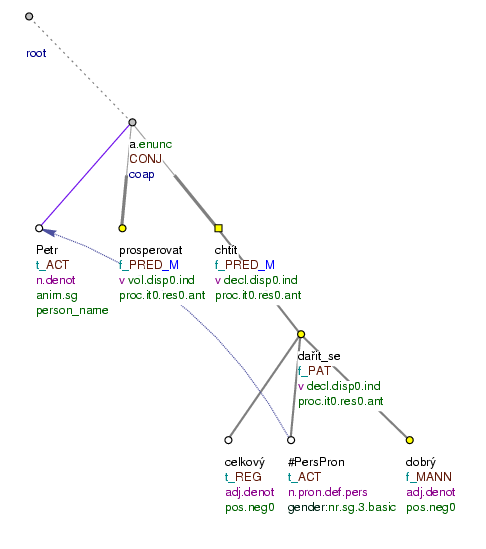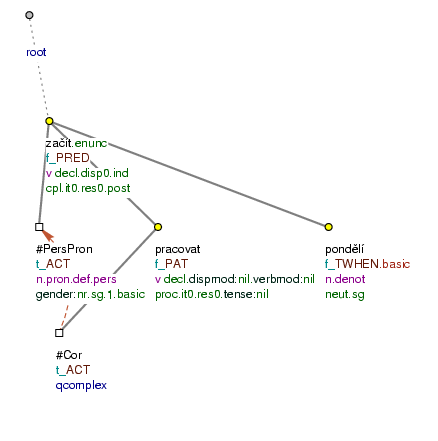Modal (Section 9.1.1, "Modal predicates") and phase (Section 9.1.2, "Phase predicates") predicates are defined as expressions comprising a modal or phase verb combined with a substantive infinitive verb. The representation of these two types in the tectogrammatical tree differs.
A modal predicate is defined as a multi-word predicate comprising a modal verb which (in addition to its grammatical meanings in the sentence) expresses the modal meaning of the predicate, and the infinitive of a substantive verb, carrying the main lexical meaning of the expression as a whole.
Modal predicates consist of:
Basic method of annotation of modal predicates. A modal predicate is represented by a single node with the t-lemma of the substantive infinitive verb. Information on the modality of this predicate expressed by the modal verb is contained in the value of the deontic modality grammateme (deontmod; see Section 5.10, "The deontmod grammateme (deontic modality)").
Examples:
Petr <chce> přijít na koncert. [ deontmod=vol] (=Peter wants to come to the concert.) Fig. 6.133
Karel <musí> udělat zkoušky. [ deontmod=deb] (=Karel has to sit the exams.)
The following combinations are represented by the basic method (by copying the nodes) :
-
(negated) modal verb + positive substantive infinitive verb.
Examples:
Karel <může> získat knihu. [
deontmod=poss] (=Karel can obtain the book.)Karel <nemůže> získat knihu. [
deontmod=poss] (=Karel cannot obtain the book.) -
(negated) modal verb + coordination of positive substantive infinitive verbs.
Examples:
Karel může získat a vrátit knihu. (=Karel can obtain the book and return it.)
Karel <může> získat [
deontmod=poss] a vrátit [deontmod=poss] knihu. (=Karel can obtain the book and return it.)Karel nemůže získat a vrátit knihu. (=Karel cannot obtain the book and return it.)
Karel <nemůže> získat [
deontmod=poss] a vrátit [deontmod=poss] knihu. (=Karel cannot obtain the book and return it.) -
a coordination of (negated) modal verbs + a positive substantive infinitive verb.
Examples:
Karel může a chce získat knihu. (=Karel can obtain the book and he wants to.)
Karel <může> {získat} [
deontmod=poss] a <chce> získat [deontmod=vol] knihu. (=Karel can obtain the book and he wants to.)Karel nemůže, ale chce získat knihu. (=Karel can't obtain the book, but he wants to.)
Karel <nemůže> {získat} [
deontmod=poss] , ale <chce> získat [deontmod=vol] knihu. (=Karel cannot obtain the book, but he wants to.) -
a coordination of (negated) modal verbs + a coordination of positive substantive infinitive verbs.
Example:
Karel může a chce získat a vrátit knihu. (=Karel can obtain the book and return it and he wants to.)
Karel <může> {získat} [
deontmod=poss] a <chce> získat [deontmod=vol] a {vrátit} [deontmod=poss] a vrátit) [deontmod=vol] knihu. (=Karel can obtain the book and return it and he wants to.)Karel nemůže, ale chce získat a vrátit knihu. (=Karel cannot obtain the book and return it, but he wants to)
Karel <nemůže>{získat} [
deontmod=poss] , ale <chce> získat [deontmod=vol] a {vrátit} [deontmod=poss] , ale vrátit [deontmod=vol] knihu. (=Karel cannot obtain the book and return it, but he wants to)Karel nemůže a nechce získat a vrátit knihu. (=Karel cannot obtain the book and return it, and he does not want to.)
Karel <nemůže> {získat} [
deontmod=poss] a <nechce> získat [deontmod=vol] a {vrátit} [deontmod=poss] a vrátit ) [deontmod=vol] knihu. (=Karel cannot obtain the book and return it, and he does not want to.)
Figure 6.133. Modal predicate
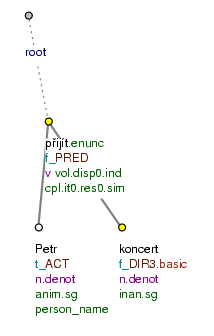
Petr chce přijít na koncert. (=lit. Peter wants to_come to (the) concert.)
Negation (see Section 9.1.1.1, "Negation of modal predicates") and co-ordination (see Section 9.1.1.2, "Parataxis with modal predicates") significantly complicate the representation of modal predicates. These complicated types are therefore described in more detail in the following sub-sections, with rules for the annotation of types which cannot be represented by the basic method of annotation. These are:
-
all modal predicates with a negated substantive infinitive verb (see Section 9.1.1.1, "Negation of modal predicates"). That is, the combinations:
-
(negated) modal verb + negated substantive infinitive verb.
Example:
Karel může nezískat knihu. (=Karel may not obtain the book.)
Karel nemůže nezískat knihu. (=Karel cannot fail to obtain the book.)
In this case the modal verb is always represented by a separate node (not by a grammateme).
-
-
cases of layering of modal meanings in one modal predicate (see Section 9.1.1.3, "Layering of modal meanings"). That is, the combinations:
-
Modal verb + modal verb + substantive infinitive verb.
Example:
Karel může <chtít> získat knihu. (=Karel may want to obtain the book.)
In this case the first modal verb is always represented by a separate node (not by a grammateme).
-
Naturally, the modal predicate can be negated. This negation can be realised either by the modal verb or by the substantive infinitive verb. The modal predicate can also be doubly negated: by negation of both of its parts.
Syntactic negation (expressed by the morpheme ne- in the case of a verb) is represented as a separate node with the t-lemma #Neg and the functor RHEM. For detailed rules regarding the positioning of this node in the tectogrammatical tree see Section 6.2, "Basic guidelines regarding the position of rhematizers in tectogrammatical trees".
The annotation of modal predicates is determined by the form of the substantive infinitive verb: whether it is positive or negative. In respect of negation we therefore divide modal predicates into two basic types of combination:
-
(negated) modal verb + positive substantive infinitive verb.
Examples:
Karel <může> přijít na koncert. [
deontmod=poss] (=Karel can come to the concert.)Karel <nemůže> přijít na koncert. [
deontmod=poss] (=Karel cannot come to the concert.) Fig. 6.134Modal predicates with a positive form of the substantive infinitive verb are represented by the basic method (see Section 9.1.1, "Modal predicates").
The node representing syntactic negation of the modal verb is represented as a daughter node of the node representing the entire modal predicate.
-
(negated) modal verb + negated substantive infinitive verb.
Examples:
Karel může nepřijít na koncert. (=Karel may not come to the concert.) Fig. 6.135
Karel nemůže nepřijít na koncert. (=Karel cannot fail to come to the concert.) Fig. 6.136
In cases with a negative form of the substantive infinitive verb both the modal verb and the substantive infinitive verb are represented by separate nodes. In the grammateme
deontmodthe valuedeclis entered at both nodes. The node representing a substantive infinitive verb has the functorPATand is dependent on the node representing the modal verb.The node representing syntactic negation of the substantive verb is represented as a daughter node of the node representing the substantive infinitive verb. The node representing any syntactic negation of the modal verb is, as a rule, represented as a direct daughter node of the node representing the modal verb.
Figure 6.134. Negated modal predicate
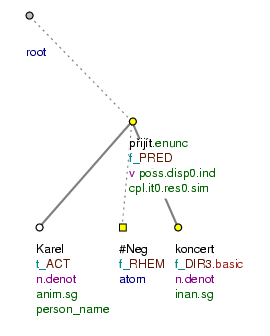
Karel nemůže přijít na koncert. (=lit. Karel cannot come to (the) concert.)
Complicated types of modal predicates occur in cases of co-ordination (occasionally apposition) of modal verbs or substantive infinitive verbs associated with modal verbs. Modal meaning is expressed only once for each of the co-ordinate substantive infinitive verbs at surface level, by a single occurrence of the modal verb. Similarly, substantive verbs are, as a rule, not repeated at surface level for each of the co-ordinate modal verbs.
All possible types, unless they involve negation of the substantive verb (see Section 9.1.1.1, "Negation of modal predicates"), are annotated by the basic method (see Section 9.1.1, "Modal predicates"). For positions where substantive verbs are unexpressed at surface level, new nodes are added in the tectogrammatical tree (by copying the nodes representing the verbs which are expressed).
The respective possible types (with no negated substantive infinitive verb) are therefore annotated as follows:
-
a (negated) modal verb + a co-ordination of positive substantive infinitive verbs.
Examples:
Petr chce odpočívat a poslouchat hudbu. (=Peter wants to relax and listen to music.)
Petr <chce> odpočívat [
deontmod=vol] a poslouchat [deontmod=vol] hudbu. (=Peter wants to relax and listen to music.) Fig. 6.137Petr nechce přijít a zůstat. (=Peter does not want to come and stay.)
Petr <nechce> přijít [
deontmod=vol] a zůstat [deontmod=vol] (=Peter does not want to come and stay). Fig. 6.138The combination of: a (negated) modal verb + a co-ordination of positive substantive infinitive verbs is interpreted as a co-ordination of two modal predicates with the same modal meaning (expressed only once at surface level, by a single occurrence of the modal verb). Each modal predicate is represented by a separate node with a t-lemma of the relevant substantive infinitive verb. In the grammateme
deontmodthe modality value corresponding to the expressed modal verb will be entered at each of these nodes (the attributea/aux.rfcontains a reference to the expressed modal verb embedded at both nodes). Cf. Fig. 6.137.In the case of syntactic negation of a modal verb, the node representing syntactic negation is represented as a daughter node of both nodes representing the modal predicates (not as shared modifiers of these predicates; cf. Fig. 6.138).
-
a co-ordination of (negated) modal verbs + a positive substantive infinitive verb.
Examples:
Karel může a chce získat knihu. (=Karel can obtain the book and he wants to.)
Karel <může> {získat} [
deontmod=poss] a <chce> získat [deontmod=vol] knihu. (=Karel can obtain the book and he wants to.)Petr nemohl a nemůže přijít na koncert. (=Peter could not, and cannot, come to the concert.)
Karel <nemohl> {přijít} [
deontmod=poss] a <nemůže> přijít [deontmod=poss] na koncert. (=Karel could not and cannot come to the concert.) Fig. 6.139Najednou mohl i chtěl pokračovat. (=Suddenly he was able to continue, indeed he wanted to.)
Karel <mohl> {pokračovat} [
deontmod=poss] i <chtěl> pokračovat [deontmod=vol] (=Karel was able to continue; indeed he wanted to.)The combination of: a co-ordination (of negated) modal verbs + a positive substantive infinitive verb is interpreted as a co-ordination of two modal predicates with different modal meanings or only with the various grammatical meanings of the substantive verb (which is expressed only once at surface level). Each modal predicate is represented by a separate node with the same t-lemma of the substantive infinitive verb. To represent one of the modal predicates, the node representing the expressed substantive verb is copied into the tectogrammatical tree. In the grammateme
deontmodthe modality value corresponding to the respective modal verb expressed will be entered at each of these nodes (in the attributea/aux.rfa reference to one expressed modal verb is given for each node).In the case of syntactic negation of a modal verb, the node representing the syntactic negation is represented as a daughter node of the node representing the modal predicate whose deontic modality value influences the negated modal verb.
-
co-ordination (of negated) modal verbs + co-ordination of positive substantive infinitive verbs.
Examples:
Karel může a chce získat a vrátit knihu. (=Karel can obtain the book and return it, and he wants to.)
Karel <může>{získat} [
deontmod=poss] a <chce> získat [deontmod=vol] a {vrátit} [deontmod=poss] a vrátit [deontmod=vol] knihu. (=Karel can obtain the book and return it, and he wants to.)Takže to nemohli a nemohou potvrdit ani vyvrátit. (=So they could not and cannot confirm or deny it.)
Takže to <nemohli>{potvrdit} [
deontmod=poss] a <nemohou> potvrdit [deontmod=poss] ani {vyvrátit} [deontmod=poss] a vyvrátit [deontmod=poss] (=So they could not and cannot confirm or deny it.) Fig. 6.140The combination of: a co-ordination (of negated) modal verbs + a co-ordination of positive substantive infinitive verbs is interpreted as a co-ordination of co-ordinations (or as an apposition of co-ordinations and other variants) of two modal predicates with different modal or just grammatical meanings of the substantive verb (which is expressed only once at surface level). Thus in the sentence four modal predicates are interpreted. Each modal predicate is represented by a separate node with a t-lemma of the relevant substantive infinitive verb. To represent one of a pair of modal predicates, the node representing the expressed substantive verb is copied into the tectogrammatical tree. In the grammateme
deontmod, for each pair of nodes with the same t-lemma, the modality value will be entered that corresponds in each case to one expressed modal verb (the reference to one of the expressed modal verbs is embedded in the attributea/aux.rffor two nodes in each case).In the case of syntactic negation of a modal verb the node representing syntactic negation is represented as a daughter node of the node representing the modal predicate whose deontic modality value affects the negated modal verb. (The syntactic negation node is established for each modal predicate separately and is not represented as a shared modifier).
Figure 6.137. Parataxis with modal predicates
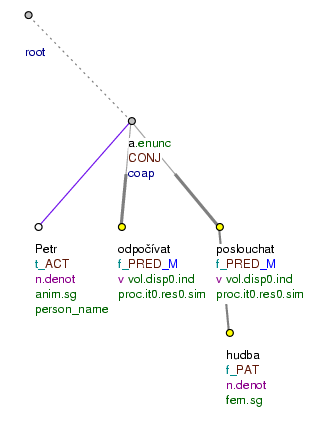
Petr chce odpočívat a poslouchat hudbu. (=lit. Peter wants to_relax and listen (to) music.)
Figure 6.138. Parataxis with modal predicates
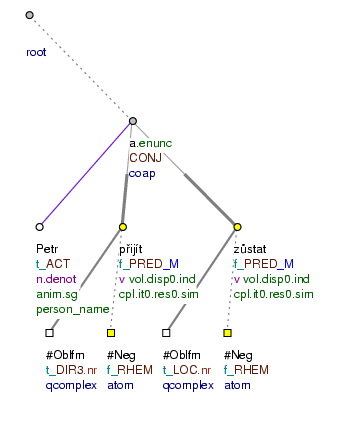
Petr nechce přijít a zůstat. (=lit. Peter does_not_want to_come and stay.)
Figure 6.139. Parataxis with modal predicates
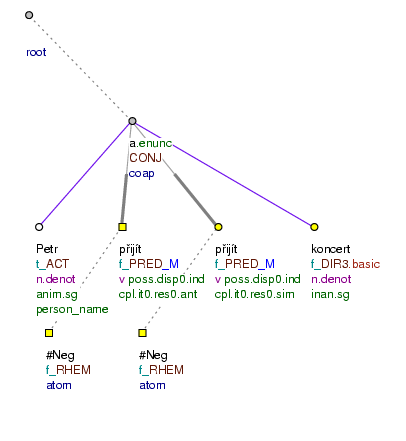
Petr nemohl a nemůže přijít na koncert (=lit. Peter could_not and cannot come to (the) concert.)
Figure 6.140. Parataxis with modal predicates
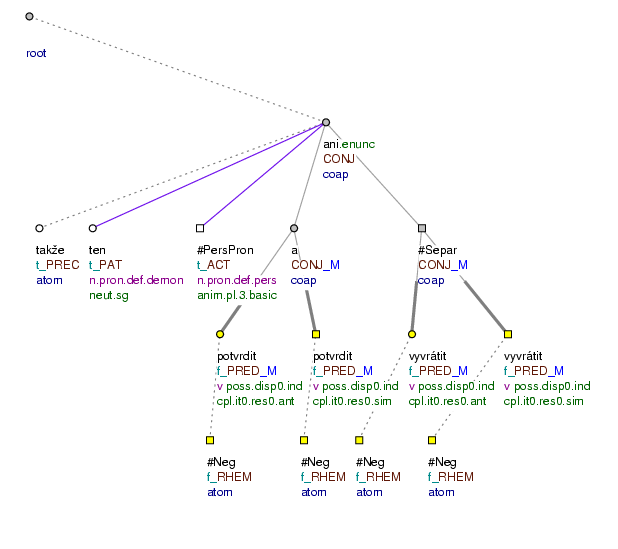
Takže to nemohli a nemohou potvrdit ani vyvrátit (=lit. So (they) it could_not and cannot confirm or deny.)
Co-ordination and a negated substantive infinitive verb. Occurrences of a negated substantive infinitive verb are annotated in a similar way, except that the modal predicate - the (negated) modal verb + the negated substantive infinitive verb - is always represented by two nodes: by a node representing the modal verb and a node representing the substantive infinitive verb (see Section 9.1.1.1, "Negation of modal predicates"):
-
(negated) modal verb + co-ordination of substantive infinitive verbs, one (possibly all) of which is negated.
Cf:
-
Petr má dovolenou, takže může odpočívat a nepracovat. (=Peter is on holiday, so he can relax and he does not have to work.)
This combination is interpreted as a co-ordination of two modal predicates with the same modal meaning expressed only once at surface level, by one occurrence of the modal verb. The modal predicate může odpočívat (=can relax) is represented by a separate node with a t-lemma of the relevant substantive infinitive verb (odpočívat (=to relax)). In the grammateme
deontmodthe modality value corresponding to the expressed modal verb will be entered at this node (deontmod=poss). The modal predicate může nepracovat (=does not have to work; lit. is able not to work) is represented by two separate nodes: by a node representing the modal verb (moci (=to be able)) and a node representing the substantive infinitive verb (pracovat (=to work)). In the attributedeontmodthe valuedeclwill be added for both nodes . The node representing syntactic negation of the infinitive nepracovat (=to not work) will be represented as a daughter node of the node representing this infinitive. Cf. Fig. 6.141.
-
-
a co-ordination of (negated) modal verbs + negative substantive infinitive verb.
Cf:
-
Petr mohl a může nepřijít na koncert. (=Peter might not have come to the concert and he may not come).
This combination is interpreted as a co-ordination of two modal predicates with different modal or just grammatical meanings of the substantive verb (which is expressed only once at surface level) . Each modal predicate (=mohl nepřijít (=might not have come) and může nepřijít (=may not come)) is represented by two separate nodes: by nodes representing the expressed modal verb (moci (=to be able) and moci (=to be able)) and by nodes representing the substantive verbs which will have the same t-lemma of the expressed substantive infinitive verb (přijít (=to come) and přijít (=to come)). To represent one of the modal predicates, the node representing the expressed substantive verb is copied into the tectogrammatical tree. In the grammateme
deontmodthe valuedeclwill be entered at each of the nodes. The nodes representing syntactic negation of the infinitives nepřijít (=to not come) are represented as daughter nodes of the nodes representing these infinitives. Cf. Fig. 6.142.
-
-
a co-ordination of (negated) modal verbs + a co-ordination of substantive infinitive verbs, one of which (possibly all of which) is negated.
Cf:
-
Karel může a chce získat a nevrátit knihu. (=Karel can obtain the book and not return it, and this is what he wants.)
This combination is interpreted as a co-ordination of co-ordinations (possibly as apposition of co-ordinations and other variants) of two modal predicates with the various modal or only grammatical meanings of the substantive verb (which is expressed only once at surface level). Thus the four modal predicates (může získat (=can obtain), chce získat (=wants to obtain), může nevrátit (=may not return) and chce nevrátit (=wants to keep; lit. wants to not return)) are interpreted in the sentence.
Modal predicates with a positive substantive infinitive verb are represented by a signle node with the t-lemma of the appropriate substantive infinitive verb. In the grammateme
deontmodat each node the modality value will be entered that corresponds in each case to one expressed modal verb.Modal predicates with a negative substantive infinitive verb are represented by two separate nodes: by nodes representing modal verbs and nodes representing infinitives of substantive verbs. To represent one of a pair of modal predicates, the node representing the expressed substantive verb is always copied into the tectogrammatical tree. In the grammateme
deontmodat each node the valuedeclis entered.Nodes representing syntactic negation of the infinitives nevrátit (=not to return) are represented as daughter nodes of the nodes representing these infinitives.
Cf. Fig. 6.143.
-
Figure 6.141. Parataxis with modal predicates with a negated substantive verb
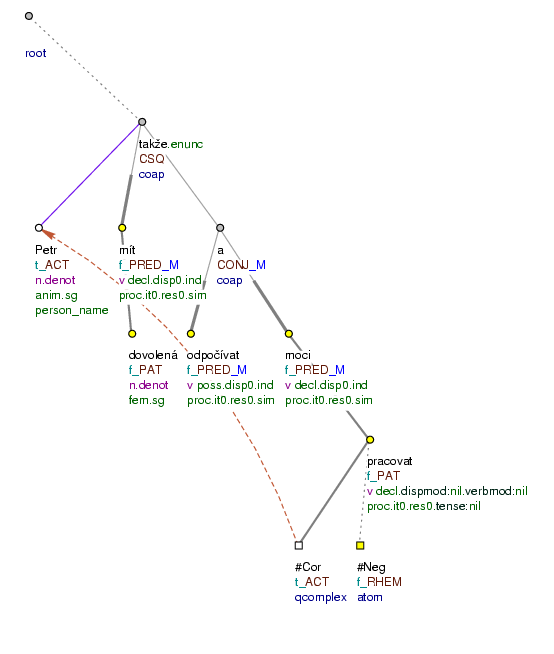
Petr má dovolenou, takže může odpočívat a nepracovat. (=lit. Peter has holiday, so (he) can relax and not_work.)
Figure 6.142. Parataxis with modal predicates with a negated substantive verb
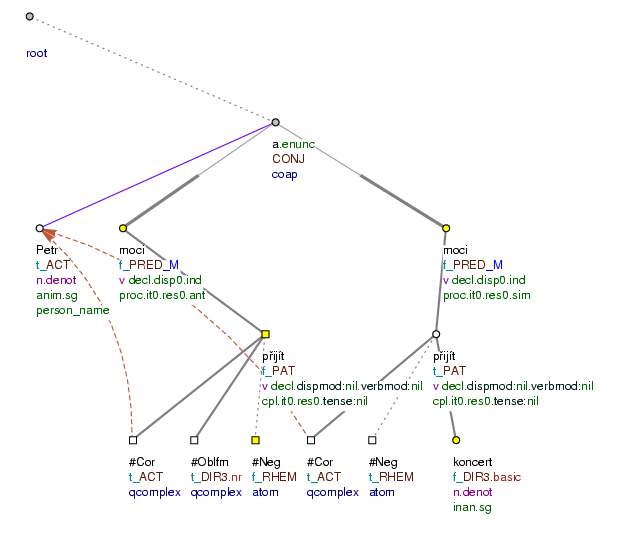
Petr mohl a může nepřijít na koncert. (=lit. Peter could and can not_come to (the) concert.)
Figure 6.143. Parataxis with modal predicates with a negated substantive verb
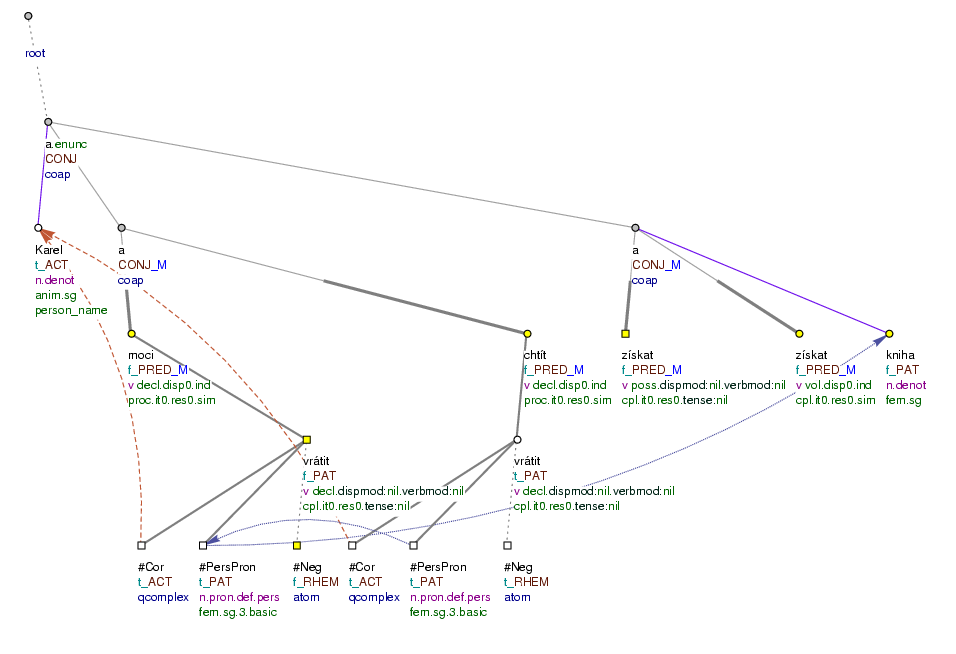
Karel může a chce získat a nevrátit knihu. (=lit. Karel can and wants to_obtain and not_return (the) book.)
On similar rules regarding the positioning of the syntactic negation node in the tectogrammatical tree see Section 6.2, "Basic guidelines regarding the position of rhematizers in tectogrammatical trees".
Modal meanings can be also layered in modal predicates. The combination:
-
modal verb + modal verb + substantive infinitive verb occurs.
Examples:
Karel může chtít získat knihu. (=Karel may wish to obtain the book.)
The first modal verb in the sequence is always represented by a separate node with the t-lemma of (the infinitive of) that modal verb. In the deontic modality grammateme the value decl is entered at that node (the modal meaning of the first modal verb is not represented by a grammateme, but by its lexical meaning).
The second modal verb in the sequence and the substantive infinitive verb are represented (unless the substantive infinitive verb is negated) by a single node with the t-lemma of the substantive infinitive verb. The deontic modality grammateme contains a representation of the modal meaning carried by this second modal verb. The node representing the second modal verb in the sequence and the substantive infinitive verb has the functor PAT and is represented as a direct daughter node of the node representing the first modal verb.
Examples:
Petr může [deontmod=decl] <chtít> přijít .PAT [deontmod=vol] na koncert. (=Peter may want to come to the concert.) Fig. 6.144
Petr musí [deontmod=decl] <umět> kreslit .PAT [deontmod=fac] (=Peter must be able to draw)
Petr může [deontmod=decl] <nechtít> přijít .PAT [deontmod=vol] na koncert. (=Peter may not want to come to the concert) Fig. 6.145
Petr nemůže [deontmod=decl] <nechtít> přijít .PAT [deontmod=vol] na koncert. (=Peter cannot not want to come to the concert) Fig. 6.146
Musím [deontmod=decl] <dovést> začít .PAT [deontmod=fac] přestat .PAT kouřit.PAT (=I must be capable of starting to give up smoking)
The above method is not used to represent the type with a negated infinitive of a substantive verb:
-
(negated) modal verb + (negated) modal verb + negated infinitive of a substantive verb.
Examples:
Petr může chtít nepřijít na koncert. (=Peter may want to miss the concert)
Petr nemůže chtít nepřijít na koncert. (=Peter cannot want to miss the concert.) Fig. 6.147
Petr může nechtít nepřijít na koncert. (=Peter may not want to miss the concert.)
Petr nemůže nechtít nepřijít na koncert. (=Peter must want to miss the concert.) Fig. 6.148
In cases with a negated substantive infinitive verb both modal verbs and also the substantive infinitive verb are represented by separate nodes. In the grammateme deontmod the value decl is entered for all three nodes. The node representing the second modal verb in a sequence has the functor PAT and is represented as a direct daughter node of the node representing the first modal verb. The node representing the substantive infinitive verb also has the functor PAT and is dependent on the node representing the second modal verb:
Petr nemůže chtít.PAT nepřijít.PAT na koncert. (=Peter cannot want to miss the concert) Fig. 6.147
Petrnemůže nechtít.PAT nepřijít.PAT na koncert. (=Peter must want to miss the concert.) Fig. 6.148
Figure 6.144. Combinations of modal verbs
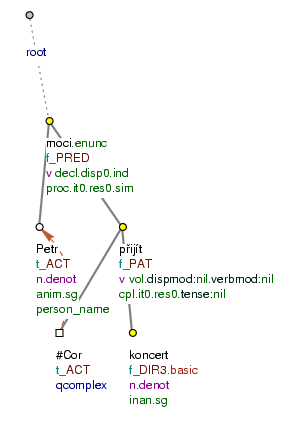
Petr může chtít přijít na koncert. (=lit. Peter may want to_come to (the) concert.)
Figure 6.145. Combinations of modal verbs
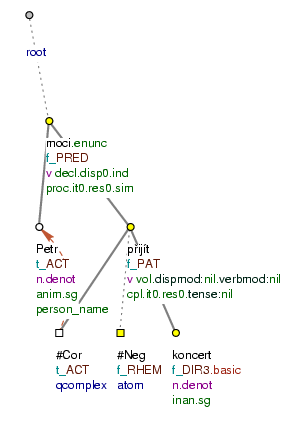
Petr může nechtít přijít na koncert. (=lit. Peter may not_want to_come to (the) concert.)
Figure 6.146. Combinations of modal verbs
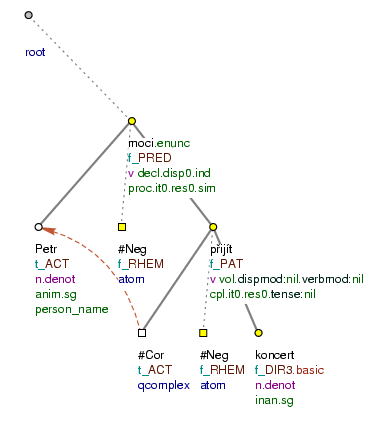
Petr nemůže nechtít přijít na koncert (=lit. Peter cannot not_want to_come to (the) concert.)
Figure 6.147. Combinations of modal verbs

Petr nemůže chtít nepřijít na koncert. (=lit. Peter cannot want to_not_come to (the) concert.)
Figure 6.148. Combinations of modal verbs
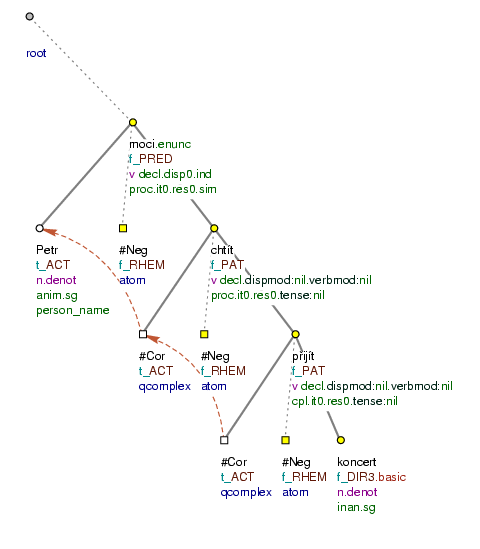
Petr nemůže nechtít nepřijít na koncert. (=lit. Peter cannot not_want to_not_come to (the) concert.).
For similar rules regarding the positioning of the syntactic negation node in the tectogrammmatical tree see Section 6.2, "Basic guidelines regarding the position of rhematizers in tectogrammatical trees".
Modal meaning can be further specified by direct modification of the modal verb (not of the substantive infinitive verb) by an adverbial expression. For example:
On vážně.ATT nemohl přijít. (=Seriously, he was unable to come.) Fig. 6.149
Zoufale.ATT chtěl reagovat. (=He desperately wanted to react.)
The difference between a modification relating only to the modal verb and a modification relating to the entire modal predicate (Musí to udělat pečlivě. MANN (=He must do it carefully)) is represented by various functors: As a rule, the node representing a modification relating only to the modal verb has the functor ATT; as a rule, the node representing the modification relating to the entire modal predicate has the functor MANN. (We are aware, however, that in certain cases the difference cannot be represented in this way.) The node representing the modification relating to the modal verb only is (in cases where the modal predicate is represented by a single node) represented as a node dependent on the node for the entire modal predicate.
In Section 9.1.1.2, "Parataxis with modal predicates" ellipses in modal predicates caused by paratactic connections were described. However, ellipsis (ellipsis of the substantive infinitive verb) in modal predicates may also be interpreted outside paratactic constructions.
Ellipsis of the substantive infinitive verb with the meaning of "motion" in modal predicates. PDT represents as elliptical (as far as modal constructions are concerned) only cases where a substantive infinitive verb signifying motion is omitted in modal predicates such as:
Kdo se bojí, <nesmí> {jít} do lesa. [ deontmod=deb] (=Those who are afraid should not go into the forest.)
<Můžu>{jít/jet} do kina? [ deontmod=poss] (=Can I go to the cinema?)
<Musím>{jít/jet} domů. [ deontmod=deb] (=I must go home.) Fig. 6.150
Chtěli jet na Slovensko, ale také <chtěli> {jet} do Prahy. [ deontmod=vol] (=They wanted to go to Slovakia, but they also wanted to go to Prague.) Fig. 6.151
These constructions are represented as modal constructions with ellipsis of the substantive verb (thus we do not consider the lexicalisation of this meaning). In place of the elided substantive infinitive verb, a new node is entered into the tectogrammatical tree, as a rule with the t-lemma #EmpVerb, or the node representing the verb of "motion" is copied from the context.
NB! The node for the empty verb (t_lemma=#EmpVerb) is a quasi-complex node (nodetype=qcomplex; see Section 8, "Quasi-complex nodes"), at which no grammatemes are entered (i.e. not even the deontmod) grammateme.
Figure 6.150. Modal predicate with ellipsis of the substantive verb of "motion"
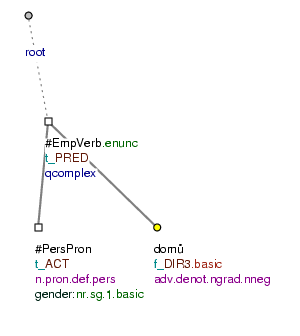
Musím domů. (=lit. (I) must (go) home.)
Figure 6.151. Modal predicate with ellipsis of the substantive verb "of motion"
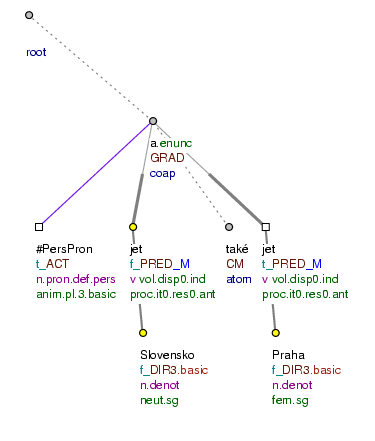
Chtěli jet na Slovensko a také chtěli do Prahy. (=lit. (They) wanted to_go to Slovakia and also wanted to Prague.)
The following cases are not interpreted as ellipsis of the substantive infinitive verb in a modal predicate::
-
modal verb + noun in the accusative
Example: chtít hračku (=to want a toy) ( Fig. 6.152).
-
modal verb + dependent clause.
Example: chtít, aby přišli (=to want them to come).
In such cases the modal verbs are represented by separate nodes. The node representing a noun in the accusative or the effective root of a dependent clause is dependent on the node for the modal verb and it has the functor PAT (=cf. Fig. 6.152).
NB! Co-ordination can give rise to a combination of modal predicates represented by a single node with cases which are not represented as modal predicates. In such cases a similar approach is adopted, according to the rules in Section 9.1.1.2, "Parataxis with modal predicates". Cf.:
-
Petr chtěl prosperovat, a aby se mu celkově dobře dařilo. (=Peter wanted to do well and to be successful in everything.)
In this construction we represent the co-ordination of the modal predicate chtít prosperovat (=to want to do well) (represented by a single node with the t-lemma prosperovat (=to do well) and with the value
volin the grammatemedeontmod) and the verb chtít (=to want) (represented by a newly established (copied) node with the t-lemma chtít (=to want)). The dependent clause aby se mu dobře dařilo (=for him to be successful) is represented by a sub-tree having a root with the functorPAT(and t-lemma dařit_se (=to be successful)) dependent on the node for the verb chtít (=to want). Cf. Fig. 6.153.
A phase predicate is defined as a multi-word predicate consisting of a phase verb which in the sentence, besides the grammatical meanings, expresses a phase of an event, and a substantive infinitive verb bearing the main lexical meaning of the expression as a whole.
In phase predicates we identify:
No grammatemes have been established to represent a phase of an event. Phase predicates are therefore always represented by two nodes: a node representing a phase verb and a node representing a substantive infinitive verb. The substantive verb node has the functor PAT and is dependent on the phase verb node.
Example:
Začnu .PRED pracovat .PAT v pondělí. (=I will start work on Monday.) Fig. 6.154
